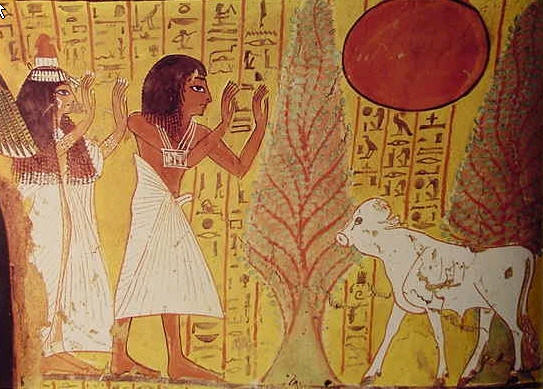"And concerning what Scripture says, 'In this year of jubilee you shall return, every one of you, to your property' (cf. Leviticus 25:13) ... The interpretation is that it applies to the Last Days and concerns the captives, just as [Isaiah said: 'To proclaim the jubilee to the captives' (cf. Isaiah 61:1) ... just as .... and from the inheritance of Melchizedek, who will return them to what is rightfully theirs. He will proclaim to them the jubilee, thereby releasing them from the debt of all their sins. He shall proclaim this decree in the first week of the jubilee period that follows nine jubilee periods. Then the 'Day of Atonement' shall follow after the tenth jubilee period, when he shall atone for all the Sons of Light and the people who are predestined to Melchizedek ... and by his might he will judge God's holy ones and so establish a righteous kingdom" (11QMelch 2:2-9).
Above is an interesting quote for sure. It shows how in-depth some were with understanding certain aspects of the appearance of the messiah, especially with respect to prophetic patterns like this jubilee period. A jubilee period is 49 years, with the jubilee occurring in the first year, thus it becomes the 50th year after a jubilee period. Apparently the "Day of Atonement" follows a 490-year period and is associated with Melchizedek.
Melchizedek is associated with the second coming in Christian tradition. Still it is fascinating that the Jews would celebrate a jubilee and be restored to their land during the last jubilee period, that is the 10th jubilee period of a 490-year period. 490 years is ten jubilees. Thus there is evidence here that even those from the 1st century thought that in the end times the Jews would be restored to their homeland during the tenth Jubilee.
Please, note, therefore that this works out quite well when the "70 weeks" are fixed by Jesus' baptism in 29 CE, which marks the 70th week of the 490-year period. This 70-week period would thus be from 455 BCE to 36 CE. But if you count down to our times from 36 CE to determine the future jubilee periods, we find one ends in 1996. That is, 4 x 490 = 1960 years. 1960 plus 36 CE = 1996. Thus the closest 490-year period during our time is from 1506-1996 and the tenth jubilee, the jubilee period that was supposed to see the restoration of the Jews to their homeland would begin 49 years earlier, which is 1947, the very year indeed that the Jews did get restored to their homeland.
Now what is even more fun, is an obvious "week" of jubilees seemed implied. That is, when each 490-year period of 70 weeks becomes one day in a seven-day week of 3430 years. If 1506-1996 is the 7th day of the week, then that week would begin in 1435 BCE. The Exodus occurs in 1386BCE, 49 years after the beginning of this week, but is appropriate as the very first "jubilee" when the Jews are released from bondage. But in that case, where you have seven days of 490 years each, there is a total of 70 jubilee periods, with the very last jubilee fulfilling the 70th jubilee. Thus 1947-1996 fulfills the "70th jubilee" for the Jews.
On the JW level, the concept of these 70 jubilees was also apparent, only they figured there was an extra year inserted between 49-year periods, so their calculation was for a period of 3500 years, which is 70 x 50, and based upon dating they later abandoned and considered erroneous, came up with 1925 as the end of this jubilee period, which I supposed relates more to the "Day of Atonement" which follows the tenth jubilee of the 490-year period.
Also quite interesting, is that Melchidek on the Day of Atonment would "atone the Sons of Light" after 1996. Per Christian doctrine, the natural Jews as "God's chosen people" would be cast out and "spiritual Israel" would then take their place. Thus the Day of Atonement would represent when the Jewish physical Covenant would become focussed on the spiritual temple being built by Christ in the form of the "144,000" (said only in general reference, since 144K represent the natural Jews within the kingdom, making up the "root" of 1/10th of the entire number, but only a technicality here; the actual entire kingdom number is 10 x 144K = 1,440,000).
Still it is a testament to the understanding of scripture that after the tenth jubilee "Melchizedek" would convert the Covenant to a spiritual one and anointed the "sons of light" at that time into the spiritual priesthood, which is pretty much the case. The Covenant was to "remain in force" until the end of the 70th week, meaning up until 1996 only. After that, it was about Melchizedek, a non-Jew becoming the messiah and building spiritual Israel.
Finally, someone mentioned a possible application of the concept of the Day of Atonement in relation to the year the Jews returned to Palestine after captivity in Babylon. Interesting that the return of the Jews in 537 BCE as far as a fulfillment of the "Day of Atonement" is shifted to a 49-year interpretation. That is the 50th year after 49 years of bondage from 587 BCE, the fall of Jerusalem. I see some very obvious problems with this application. For one, the day of Atonement was to occur in the 50th year after the initial "tenth" jubilee. If the Day of Atonement is thus to be fulfilled by the restoration of the Jews in the 1st of Cyrus, then it would have to follow 49 years of the Jews already returned as it would in the case of 1947 marking the jubilee of the Jew's final return and the Day of Atonement occurring 49 years later in 1996.
On the other hand, 1996 does not simply end 49 years of the tenth jubilee, it is also the first year following 490 years. In that sense, the year the Jews returned if it were to fulfill the Day of Atonement, would be fuilfilled if the year the Jews returned was the first year of a new 490-year period. But this is precisely another reason for beginning the 490 years from 455 BCE to 36 CE with the return of the Jews in the 1st of Cyrus, which is the conclusion made popular in 1913 by Martin Anstey in his Romance of Bible Chronology. This meant, of course, an 82-year adjustment in the Persian timeline to do this.
Also arguing against a 49-year fulfillment so that 537 BCE becomes the Day of Atonment For the Jews in relation to their period of bondage is the fact that the last 70 years of Jewish "servitude" per Jewish historical understanding via Josephus is that those last deported in year 23 of Nebuchadnezzar are the ones who served the specific 70 years for Nebuchadnezzar and his sons. That means that the actual final bondage of the entire Jewish nation did not begin in relation to the destruction of Jerusalem which occurred 4 years earlier in the 19th year of Nebuchadnezzar. So 49 years prior to the return of the Jews from Babylon the entire nation of the Jews would have been in bondage already for 24 years. And mind you, this is not the Biblical interpretation here, but the common Jewish traditional historical history for what happened 70 years before their return:
Antiquities of the Jews, 11.1.1 "
IN the first year of the reign of Cyrus 1 which was the seventieth from the day that our people were removed out of their own land into Babylon , God commiserated the captivity and calamity of these poor people, according as he had foretold to them by Jeremiah the prophet, before the destruction of the city, that after they had served Nebuchadnezzar and his posterity, and after they had undergone that servitude seventy years, he would restore them again to the land of their fathers, and they should build their temple, and enjoy their ancient prosperity. And these things God did afford them; for he stirred up the mind of Cyrus , and made him write this throughout all Asia : "Thus saith Cyrus the king: Since God Almighty hath appointed me to be king of the habitable earth, I believe that he is that God which the nation of the Israelites worship; for indeed he foretold my name by the prophets, and that I should build him a house at Jerusalem , in the
Of course, you can have the Day of Aontement fulfillment for the year the Jews return from Babylon if it follows a 490-year period, which it would when the 1st of Cyrus is correctly dated to 455 BCE, now confirmed by the VAT4956 astronomical text which includes the original dating for year 37 of Nebuchadnezzar in 511 BCE. So there is no way a Day of Aontement concept would ever work involving the 50th year after 49 years per my interpretation, and that includes Jewish traditional interpretation as well that the Jews last deported served a full 70 years of "servitude." The idea that Jerusalem fell in 587 BCE is so completely outdated now it's a JOKE. Even so, it is interesting that some focus on the "tenth jubilee" still gets fulfilled by 1947-1996, since no one argues the ending of the 70 weeks in 36 CE, though they debate over what happened at the beginning of the 70 weeks in 455 BCE, either the 1st of Cyrus or the 20th of Artaxerxes (or the 10th of Artaxerxes per secular chronology).
James Canaan
http://www.geocities.com/siaxares/jcovwk1996G.GIF (Jewish Covenant Week Chart)



